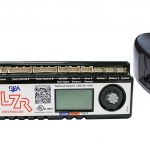This Decoded column is the first in a new question-and-answer format. During the past 13 years I’ve covered just about every code-related topic, so it is time for a new approach. The new format gives you the opportunity to send me your most pressing questions about codes. You can submit your questions at iDigHardware.com/decoded-qa, and I will answer as many as I can in future Decoded columns.
This Decoded article will be published in the April 2023 issue of Door Security + Safety
.

 Question: When swinging doors are equipped with automatic operators, are safety sensors required in order to prevent the door from hitting a building occupant in its path?
Question: When swinging doors are equipped with automatic operators, are safety sensors required in order to prevent the door from hitting a building occupant in its path?
Based on the model codes and referenced standards, the answer to this question depends on two variables:
- What type of automatic operator is installed, and
- How the automatic operator is actuated
There are three general categories of automatic operators for swinging doors, and three ways that the doors may be opened:
- Power assist operators – These operators reduce the opening force required to operate the door manually, but they do not automatically open the door. The standard that addresses this type of operator is called ANSI/BHMA A156.19 – Power Assist and Low Energy Power Operated Doors. The standard does not require doors with power assist operators to be equipped with safety sensors because the doors are opened manually, not automatically, limiting the risk of accidental contact with a building occupant.
- Low energy operators – Most doors with low energy operators may be operated manually or automatically. For automatic operation, a “knowing act” is typically used, such as an actuator mounted on the wall, an access control device, a wireless transmitter, or the act of pushing or pulling the door to begin the automatic cycle. Once actuated by a knowing act, the door will open automatically, unlike a power assist operator which only reduces the opening force for manual operation. Low energy operators that are initiated by a knowing act must comply with the ANSI/BHMA A156.19 standard, which does not require safety sensors.
- Power operated pedestrian doors – These doors are often found on entrances to large retail stores and in other locations where the doors are almost always operated automatically. The automatic operators are typically actuated by sensors, rather than by a knowing act. In comparison with low energy operators, power operated pedestrian doors normally open more rapidly and with more force and must comply with a different ANSI/BHMA standard called A156.10 – Power Operated Pedestrian Doors. This standard also addresses doors with low energy operators that are not actuated by a knowing act, for example, low energy power operated doors that are initiated by a sensor detecting a building occupant. Automatic doors required to comply with A156.10 do require safety sensors (or safety control mats – see below).
In summary, safety sensors are required for automatic doors that must comply with the A156.10 standard, including power operated pedestrian doors, and low energy power operated doors that are not initiated by a knowing act.
There are a few additional considerations regarding safety sensors. Although overhead or door mounted presence sensors are commonly used to monitor the safety zone in the vicinity of an automatic door, control mats are an alternative that is allowed by ANSI/BHMA A156.10. Safety control mats prevent an automatic door from opening or hold the door open to avoid contact with a building occupant during the door’s swing.
Beginning with the 2017 edition of the A156.10 standard, safety sensors and safety control mats must be monitored. Door systems complying with the standard must include a means to verify that the safety devices are functional, and that there is communication between the automatic door control system and each sensor or control mat. If a fault is detected, the automatic operator cannot function until the fault is corrected. Monitoring of the safety sensors must occur at least once before each closing cycle, but some systems also monitor the sensors before each opening cycle. The intent of the requirement for monitoring the sensors is to decrease the possibility of injury or entrapment caused by automatic doors with missing, disabled, disconnected, or defective safety sensors and safety control mats.
Most doors that are required by the A156.10 standard to have safety sensors are also required to have guide rails. These rails help to control the flow of traffic through the automatic doors to minimize the chance of injury. Walls or other means of separation may be used in place of the guide rails, if they meet the requirements for the rails listed in A156.10. One exception to the need for guide rails is when automatic swinging doors are installed in a hallway. If the distance between the wall and the door in the 90-degree open position does not exceed 10 inches, guide rails are not required. This requirement does not apply to doors addressed by ANSI/BHMA A156.19.
For more information on this topic, refer to the ANSI/BHMA standards and the adopted codes. State and local codes may include additional requirements that could affect these openings. The Authority Having Jurisdiction (AHJ) is responsible for making determinations related to code compliance.
You need to login or register to bookmark/favorite this content.









Leave A Comment